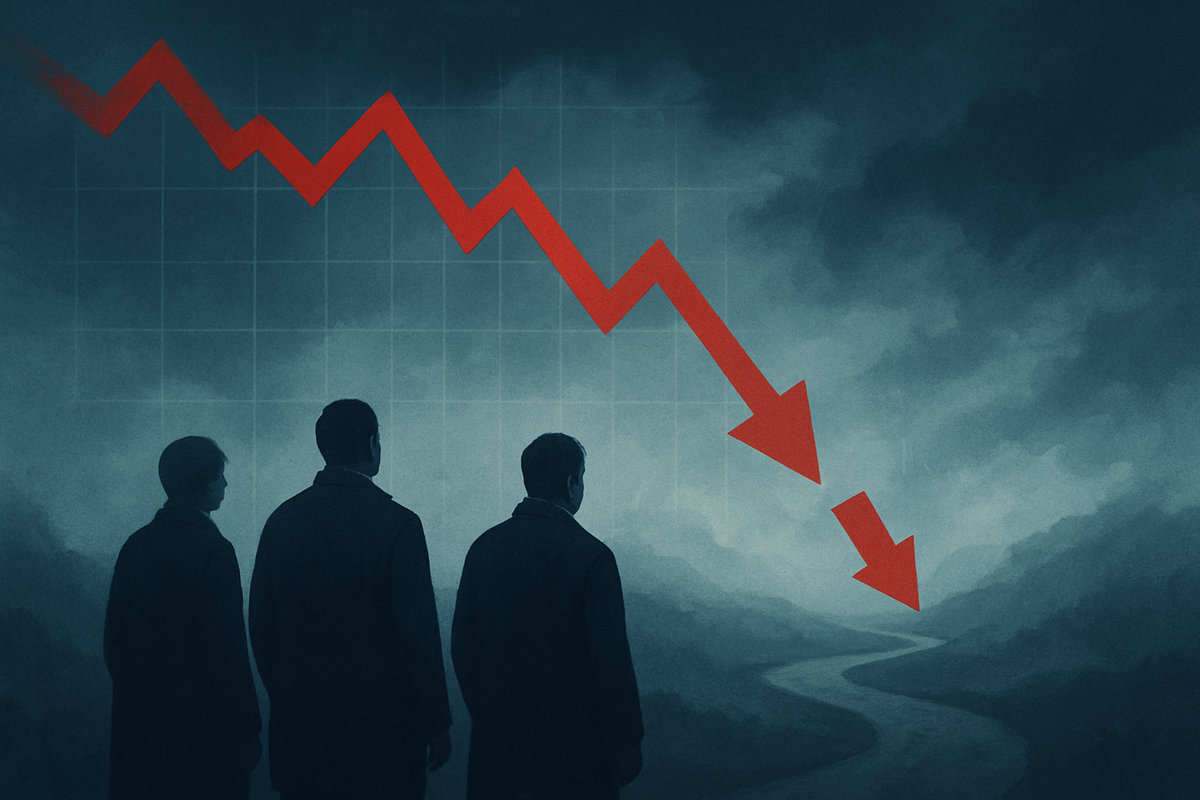
In the dynamic world of finance, where fortunes are made and lost in the blink of an eye, a chilling sentiment has begun to grip investors: the idea that stocks can, indeed, go down. This isn't merely a theoretical understanding; it's a palpable fear translating into cautious market behavior and a re-evaluation of risk. As of early November 2025, a pervasive sense of apprehension is influencing investment decisions, driven by a confluence of economic uncertainties, geopolitical tensions, and deeply ingrained psychological biases that amplify the pain of potential losses.
This growing trepidation signals a potential shift from an era of seemingly relentless market ascent to one where volatility and corrections are increasingly expected. The immediate implication is a more conservative approach to investing, with capital flows potentially redirecting from high-growth, speculative assets to more stable, defensive holdings. This psychological pivot has the power to reshape market trends, corporate strategies, and even regulatory responses, setting the stage for a potentially turbulent yet transformative period in financial history.
The Psychology of Fear: Unpacking Market Jitters
The phrase "taking fright at the idea that stocks can go down" perfectly encapsulates a set of powerful psychological biases that often lead to irrational behavior during market downturns. At its core is loss aversion, a fundamental concept in behavioral finance where individuals feel the pain of losses approximately twice as strongly as they experience the pleasure of equivalent gains. This disproportionate emotional response often drives investors to make impulsive decisions, such as selling off assets at market bottoms, thereby locking in losses that might otherwise be temporary.
This phenomenon is further exacerbated by herd mentality, where investors, during periods of decline, tend to follow the crowd, assuming others possess superior information. This collective selling can create a domino effect, intensifying market drops. Panic selling, driven by the intense fear of further losses, frequently leads investors to liquidate holdings at the worst possible time. Confirmation bias causes investors to seek and interpret information that confirms their pre-existing fears, while recency bias leads them to believe that recent negative trends will continue indefinitely. Finally, overreaction to media headlines, often sensationalized, can trigger impulsive decisions that deviate from well-constructed financial plans. These biases collectively contribute to a "market psychology" where emotions can overshadow fundamental analysis.
Several recent triggers are fueling this apprehension. Geopolitical tensions and trade uncertainty, particularly surrounding U.S. trade policies and the introduction of "Liberation Day tariffs" in April, have caused significant market fluctuations. Hawkish central bank policies aimed at combating persistent inflation, coupled with rising interest rates, are increasing borrowing costs and dampening economic growth prospects. Concerns about stretched valuations, especially within the artificial intelligence (AI) sector, are drawing comparisons to historical bubbles like the dot-com era, raising questions about the sustainability of recent gains and the potential for a significant pullback. Disappointing corporate earnings from bellwether companies, significant foreign capital outflow, and delays in key economic data due to government shutdowns further erode investor confidence. The Volatility Index (VIX), often called the "fear index," has seen spikes, notably to 52 in April 2025 and near 23 in October 2025, signaling heightened uncertainty.
Winners and Losers: Navigating a Fearful Market
In an environment dominated by investor fear, capital naturally flows towards perceived safety, creating distinct winners and losers across sectors and public companies. This flight to quality generally benefits "defensive" sectors that provide essential goods and services, which tend to exhibit inelastic demand regardless of economic conditions. These companies typically have low beta, steady cash flows, and a history of consistent dividend payments.
Winning Sectors and Companies:
- Healthcare: Demand for medical services, pharmaceuticals, and devices remains constant. Companies like Johnson & Johnson (NYSE: JNJ) and Regeneron Pharmaceuticals (NASDAQ: REGN) are often considered defensive plays.
- Utilities: Essential services such as electricity, water, and gas are always in demand. Utilities often provide reliable dividends and can benefit from lower interest rates.
- Consumer Staples: Producers of everyday necessities like food, beverages, and household goods see sustained demand. Examples include Procter & Gamble (NYSE: PG), Coca-Cola (NYSE: KO), PepsiCo (NASDAQ: PEP), and discount retailers like Walmart (NYSE: WMT).
- Financial Advisors and Accountants: During uncertainty, demand for professional financial guidance and planning often rises.
Conversely, "cyclical" sectors and companies, highly sensitive to the overall economic cycle and consumer discretionary spending, are highly likely to suffer. When fear leads to expectations of an economic downturn, consumers and businesses cut back on non-essential purchases, leading to reduced sales and profits.
Losing Sectors and Companies:
- Consumer Discretionary: This includes non-essential goods and services. Automobile manufacturers (e.g., Volkswagen, Ford), airlines (e.g., Delta, United Airlines), hotels, restaurants, and luxury goods producers (e.g., LVMH, Hermès) face significant declines as consumers tighten their belts.
- Manufacturing and Industrials: These sectors face reduced demand, disrupted supply chains, and limited access to capital.
- Financial Services: Banks and investment firms can be hit hard by rising default rates, tighter lending standards, and declining asset values.
- Energy: Demand for energy typically falls with economic activity, impacting oil and gas companies.
- Construction and Real Estate: Reduced consumer confidence and tighter credit conditions lead to fewer home purchases and construction projects.
- Information Technology: While often seen as resilient, the IT sector can suffer as companies reduce spending on technology during recession fears, impacting growth prospects.
Broader Implications: A Shift in the Financial Landscape
The widespread investor fear of market downturns is not an isolated event; it fits into broader industry trends and carries significant wider implications across the financial ecosystem. It contributes to increased market volatility and a visible shift towards a more bearish sentiment, forcing a re-evaluation of asset valuations, particularly for companies that thrived on cheap capital. This fear accelerates the shift towards defensive sectors and value investing, as investors prioritize companies with strong current earnings and robust business models over pure growth strategies. Trading patterns also alter, with increased volumes during sell-offs and a heightened focus on risk management, as investors trim equity exposure in favor of safer assets like bonds.
The ripple effects extend to competitors and partners. Less resilient competitors in vulnerable sectors may face increased pressure, potentially leading to market consolidation or bankruptcies. Supply chain partners could experience significant disruptions if key clients scale back operations. Widespread fear can also lead to reduced liquidity and increased borrowing costs for businesses, hindering investment and expansion plans.
Regulatory bodies and governments often respond to market instability caused by fear. Increased regulatory scrutiny is common, with financial institutions expected to share updates on risk assessments and compliance. Monetary policy interventions from central banks, such as interest rate cuts and quantitative easing, aim to inject liquidity and restore confidence. Governments may also implement fiscal measures or bailout packages. Furthermore, new legislative proposals or changes in tax policy can heighten investor unease, potentially leading to capital flight.
Historically, investor fear has been a central theme in numerous market downturns. The Great Crash of 1929 was a profound "crisis of confidence" that ignited the Great Depression. The Dot-Com Bubble of 2000 saw "irrational exuberance" followed by widespread fear when the bubble burst. The 2008 Financial Crisis, intensified by the collapse of Lehman Brothers, led to panic selling and a severe market crash. More recently, the 2020 COVID-19 market crash saw a rapid 35% drop in the S&P 500 (INDEX: SPX) due to lockdowns, triggering global government and central bank responses. A hypothetical "2025 Market Crash," described as policy-induced by new tariffs, also caused rapid panic selling, exposing vulnerabilities. While each event had unique triggers, the common thread is the powerful interplay of greed, fear, and speculative frenzy, with fear often exacerbating downturns into full-blown crises.
What Comes Next: Navigating the Uncertain Path Ahead
The path forward, shadowed by investor fear, presents a range of short-term and long-term possibilities, demanding strategic pivots from both companies and investors. In the short term, continued market volatility is expected. Analysts foresee a potential minor market pullback of 5% to 10%, viewed by some as a healthy correction. Major institutions like Goldman Sachs (NYSE: GS) and Morgan Stanley (NYSE: MS) have warned of a 10% to 20% pullback in equities within the next 12-24 months, with some even projecting up to a 30% drop over the year. A rotation from growth stocks, particularly in tech, towards value stocks is anticipated, driven by concerns over stretched valuations. Geopolitical tensions and policy changes, such as tariffs, will continue to spark immediate volatility.
The long-term outlook offers more extreme scenarios. If current high valuations in certain sectors, especially technology, indicate a "classic price bubble," a significant and prolonged market downturn could unfold, particularly given elevated Cyclically Adjusted P/E (CAPE) ratios. Conversely, historical data shows that negative one-year market periods are often followed by strong three-year rebounds, suggesting downturns can be lucrative entry points for long-term investors. A J.P. Morgan Research report from late 2025 indicated a 40% probability of a U.S. and global recession by the end of 2025, but not as the most likely outcome.
Strategic pivots for companies will include supply chain diversification and localization to mitigate trade policy impacts, intensified cost management and efficiency drives, and the adoption of flexible and agile business models. Continued investment in technology, particularly AI, cybersecurity, and cloud computing, remains crucial for competitiveness, alongside maintaining strong balance sheets.
For investors, a disciplined and long-term approach is paramount. This includes diversification across asset classes and international markets, a focus on quality and value by shifting towards defensive and dividend stocks, and considering inflation hedges like gold. Dollar-cost averaging, rebalancing portfolios, and maintaining liquidity are essential tactics to mitigate volatility and capitalize on opportunities. Above all, resisting emotional decisions and maintaining a long-term perspective will be critical.
Market opportunities will emerge from undervalued assets during corrections, resilient defensive sectors, fixed income and safe-haven assets, and transformative emerging technologies like AI. Challenges will include diminished investor confidence, tighter credit conditions, reduced consumer demand, ongoing supply chain disruptions, and the inherent risks of high market valuations and geopolitical uncertainty. Potential scenarios range from a controlled correction and gradual recovery to a prolonged downturn, a stagflationary environment, or even a "run it hot" economy if deregulation and lower interest rates prevail.
Conclusion: Navigating the Tides of Sentiment
The current climate of investor fear regarding market downturns underscores a fundamental truth: financial markets are not solely driven by economic fundamentals but are profoundly influenced by human psychology. The "taking fright" phenomenon, fueled by deeply ingrained biases like loss aversion and herd mentality, has immediate and far-reaching implications, from shifting capital flows to prompting regulatory scrutiny and reshaping corporate strategies.
Moving forward, the market will likely be characterized by continued vigilance. While historical data offers comfort regarding long-term recoveries, the short-term path could be volatile. Investors should heed the lessons of past downturns, recognizing that emotional reactions often lead to suboptimal outcomes. A balanced approach combining a keen eye on key economic indicators—such as inflation, employment data, and central bank guidance—with a disciplined, long-term investment strategy is essential. Monitoring corporate earnings and valuations, geopolitical developments, market breadth, and credit risks will provide crucial insights.
The lasting impact of this period of apprehension will likely be a reinforcement of the importance of diversification, a focus on quality, and the resilience required to navigate market cycles. While fear can be a powerful deterrent, it also creates opportunities for those who remain rational and strategic. The coming months will test the resolve of many, but for the discerning investor, understanding the interplay of psychology and market dynamics will be key to weathering the storm and seizing potential gains.
This content is intended for informational purposes only and is not financial advice.






